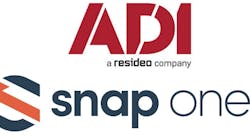Access control readers are not new and neither is integration but the improvements being made in the integrated reader arena symbolize a positive progression. According to industry insiders, smart cards, biometrics, multi-tech cards and systems, and newly partnered platform architectures all are leading the way for the industry.
Smart cards offer enhanced memory capacities and offer the possibilities of additional functionality, as well as being required for newer biometric templates. Multi-factor authentication algorithms based on biometrics in combination with pin numbers and digital signatures involve the use of these new design card types and usher in the future by providing the transitional gateways and future-proof solutions today’s regulation-driven, security conscious yet fiscally malnourished market demands.
Manufacturers are altering their tactics to meet the challenge by partnering their marketing and working towards open architecture systems. This is the same tsunami that has swept over the installation segment of the security industry with the move towards convergence and adoption of network protocols and topologies in every aspect of security including access control.
Loren Lloyd, central regional sales manager, AMAG Technology, offers his predictions for markets, applications and new developments. “Card reader offerings continue to focus on refining smart card functionality in association with biometrics,” he states. Multi-technology readers also continue to provide the transition bridge from older reader technology investments to new reader technology.
Karen Evans, president of Sielox, concurs. “We are seeing more smart cards now, with their added advantage of providing more data and control at the access point. Biometrics is also growing in popularity since positive verification is more certain and there is no card to get damaged or lost. In addition, third party interfaces are being developed for sharing data and/or events. A number of manufacturers are also forming partnerships or working internally to bring multiple systems together to work on a single platform.”
Bill Gioia, marketing manager for Gate and Access Products, Chamberlain Professional Products, is considering the following in his marketing plan for 2007: “Although many technologies have existed for years, we are seeing more demand for integrated readers that combine RFID with Prox readers or biometrics. Systems are being called upon to manage multiple credentials and offer users multiple choices.”
Federal Home Security mandates are a strong motivator for some high-end development. They allow much of the groundwork to be done as systems are deployed and public acceptance is achieved for the new solutions. According to the panel of industry experts included in this article, it isn’t all government driven either, with corporate and private sectors each being strong drivers in the move towards enhanced life safety and security.
Varying access control technologies have already been in use for quite a while. They have undergone fine tuning and refinements. Now it is largely an issue of selecting the combination of technologies to be used for different situations that each have special requirements based on the perceived threat levels under which they operate.
“Right now the vertical markets where we are seeing the most movement are schools, particularly K-12, municipal courtrooms and government applications. These are not new markets for access control, but there is a great deal of growth as security becomes a more high profile issue and access control is integrated into new locations within these markets,” says Evans.
“Some of the most active markets include apartment conversions, high-end condo or loft complexes, and large gated communities,” states Gioia. “These facilities are adding telephone access systems, gate operators, and multiple access points for access to the grounds, pools, equipment rooms, etc.”
Lloyd comments, “Convergence of readers and network protocols will provide new prospects across all vertical markets. The organizations that have already advanced their networking capabilities will most likely be the frontrunners to install the IP-based readers. Smart card readers will soon become standard in most applications due to more attractive cost and the multifaceted functionality offered the user via a variety of applications available to exploit the individual memory segments.”
New technologies have brought better functionality and lower costs; the marketplace has grown into one where the security accountability and safety that systems can deliver are no longer considered luxuries but instead necessities. Gated communities, condo-conversions, educational facilities, parking garages and video surveillance/door control systems as well as courts and municipal government work were all specific growth areas cited by the insiders, whose business is to stay aware of where the demand is coming from.
“Demand for ‘true’ perimeter access control is growing,” Chamberlain’s Gioia points out, “as more applications realize the need to control access to restricted areas or to manage select time of access to areas.”
According to Lloyd, AMAG products are most often used where event based recordings are desired for deterrent and investigative purposes.
As far as Sielox, Evans says, “the most common applications would typically include elevator control, turnstiles in every kind of facility and parking garages and lots.”
Network technology has also turned the corner with respect to the degree of deployment and public acceptance, along with the cost of implementation, making the transition of security systems and equipment into network applications and appliances virtually assured. Network-ready card readers, door controllers, video cameras and security sensors along with PC-based storage and Internet oriented connectivity provides the security solutions that make sense, save dollars and improve the lifestyles of more individuals in an ever expanding market.

